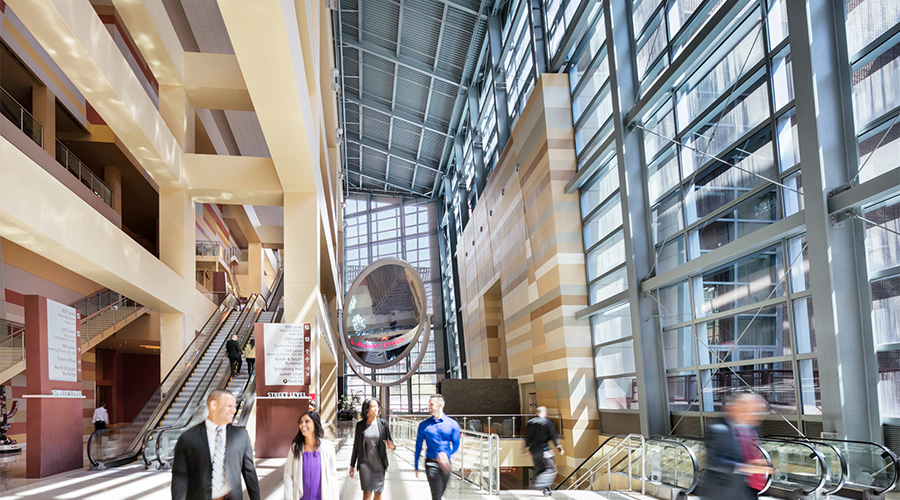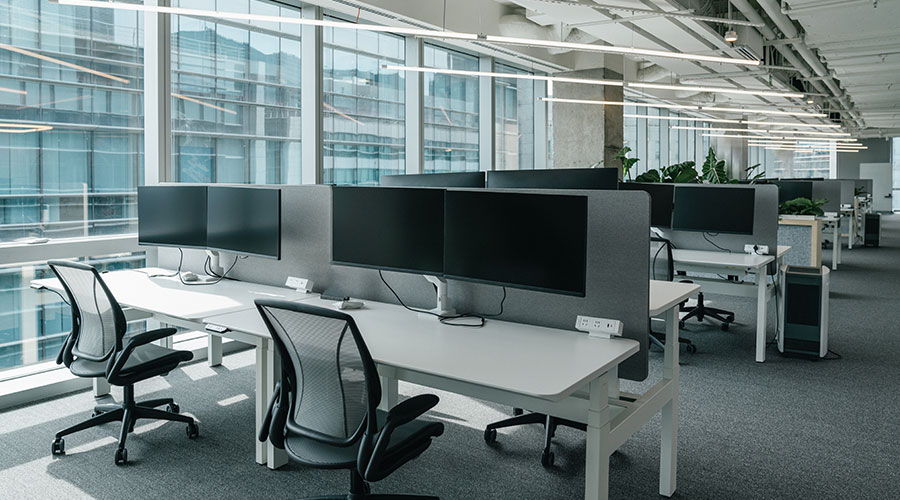Lighting 101: Key Principles to Remember
The goals of designing a typical lighting system seem straightforward. The space should look great. The space should still look great after a year or two. The design should fit the budget. It should be appropriately energy efficient.
Sounds simple, right? But let's break this down a little.
How do we make the space look great, and what does that really mean?
Looking great means something different for a lobby than it does for an office than it does for a hospital patient room. It could mean that it looks like a million bucks and people just want to be associated with this place. It could mean that the lighting is very comfortable, so long periods of time spent in the space don't cause eye strain or leave occupants feeling dismal or depressed. It could mean that it incorporates daylight (when available) so that occupants don't feel cooped up.
So how do we make it look great?
Well, the architect will be mostly responsible for the daylighting component, but when designing an electric lighting layout, there are generally three main things to think about:
- How do the fixtures look?
- How much light are we getting?
- Where is the light going, and what is it doing?
- Which fixtures are we using?
In general, a working sample (with cord and plug, and specified lamp) of any fixture should be physically reviewed to confirm that it meets the desired aesthetic of the space and that there are no flaws such as glare, visible lamps or poor light distribution that cannot be determined merely from a picture of the product. Unfortunately, fixture appearance is generally related to cost — it's always easier to find a cheaper replacement, but if it isn't truly suitable for the space that's intended to be created, that's obviously undesirable.
Light Quantity
Enough light is important not only from a task specific standpoint, but also from an aesthetic standpoint. If a lobby feels gloomy — not a synonym for dramatic — then that's not going to have a very welcoming quality. Dark caves are refuge for none but bandits or heroin addicts.
Note that this can also be a function of fixture performance, and a downlight isn't necessarily a downlight isn't necessarily a downlight. Some are glary, some trap as much as 70 percent of the light within the fixture, and they obviously come in all sorts of sizes, shapes, light distributions, incorporate varying qualities of ballasts, and utilize different lamps altogether. But this doesn't just pertain to downlights. It also pertains to uplights.
Some of this will be obvious when running photometric calculations, but some of this can only be confirmed with a fully functioning fixture sample. Fixtures that are not turned on are never glary.
Light Distribution and Quality
In an office, uniform distribution of light is generally beneficial, but in other types of spaces more targeted lighting may be desired. In any case, it's about location, location, location. Put the light where it's needed and leave it out where it's not.
For a large open office, if you know that a 10–foot wide path by the core wall is always going to be used for circulation, it would be fine to stop fixtures short of that area, except for what might be used to illuminate the wall. The light level required for an office (typically 30 to 50 footcandles) is much more than is required for a corridor, and “spill light” from the lights over the open office can contribute the necessary illumination.
Another example would be a restroom. Sconces or other optimally diffuse fixtures at a vanity can contribute sufficient illumination out into the circulation area without having to add downlights for a transitional space where less lighting is required.
In any case, the light source used should be matched with what is to be illuminated. For example, all woods look great under incandescent but only some look good under a warm fluorescent, LED, or metal halide. A very white space may appear “pristine” when illuminated with cool white sources, but it actually psychologically feels colder as well. In offices, cool white fluorescent is often used because of the idea that it keeps occupants more alert, while warm white fluorescent feels much more like incandescent and tends to create a more comfortable environment.
Quality vs. Quantity
Care should always be taken in planning which surfaces are to be illuminated within a space. In a lobby, if only downlights are used, and the walls and ceiling are not illuminated, high light levels might be achieved as well as a very oppressive environment. Whereas, if ceiling and walls are illuminated (ideally because there's something at those locations to illuminate, either architecturally or decoratively) then much lower light levels can be provided at the ground and task level with the result being a much more comfortable and welcoming space.
Another example would be an office environment. Using indirect illumination and providing fixtures that give at least a soft wash of light to walls gives much more even illumination and significantly reduces eye strain. Because of this, lighting approaches that achieve more illumination at the work source but contribute little or no uplight or illumination of walls may not at all be desirable.
Keeping a Space Looking Great
How do we ensure that the space will still look great after a year or two?
This is all about making the system as low-maintenance as possible, and there are a lot of things that can be done on the design end:
Use as few different lamp types as possible. It's a lot easier to keep four or five lamp types in stock than 56.
Don't use reflector lamps with more than one beam distribution or wattage, and ideally don't use reflector lamps at all. The lamps look pretty much the same out of the box, so it's fairly easy to put a spot distribution lamp where a flood should go or a 35W lamp where a 50W used to be. (Varying outputs and beam distributions can be created using accessory lenses that will remain in the light fixture once initially installed and aimed.)
Don't use products from manufacturers not known to be 100 percent reliable (i.e., they've been used in the past without incident, and they have a good reputation). Good products will stick around, but the new stuff that doesn't work tends to disappear after a year or two.
Use lamps of a single color temperature and, ideally, from the same manufacturer. It's easy to confuse and mismatch lamps otherwise, and although occupants may not notice that the same types of lights are all different colors, they'll sense the haphazardness.
Dimming, Sensing, Control
Incorporate daylight dimming or switching. Assuming the system is commissioned properly so that fixtures don't constantly turn on and off, this will extend the life of lamps and ballasts.
Incorporate occupancy sensors. Again, assuming the system is commissioned properly so that fixtures don't constantly turn on and off, this will extend the life of lamps and ballasts.
Provide a fully programmable centralized control system with an internal time clock. By automating the control system you can be assured lights will turn on and off when they're supposed to. Some of these systems, such as DALI type systems, can even tell maintenance when and where lamps have burned out.
Don't locate fixtures in hard-to-reach locations. If a fixture is particularly troublesome to get to, it is unlikely that it will be maintained. Locating fixtures so that they can only be accessed by leaning over the side of a 50-foot lift may seem exciting at first, but it's not nearly as exciting as it will be when jet packs are perfected.
If incandescent has to be used, provide a dimming system so that lamp life can be increased. Note that in the case of halogen, the system must be programmed so that the halogen cycle can be allowed to function periodically, or the lamp life will actually be significantly degraded.
If adjustable fixtures are used, provide them with locking adjustment. Otherwise anyone accessing the fixtures can (and usually will) unintentionally redirect these to aim more or less randomly. This does not look good.
Related Topics:













